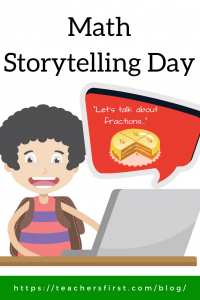 Not all elementary teachers love teaching math, but I do. I love encouraging classroom discussions about different ways to solve problems and think about math concepts. I love seeing students frustrated by a new skill and building confidence as they gain knowledge. I love it when I meet incoming students who say their favorite subject is math. I love the abundance of resources and methods for learning math content. I love it when support teachers come into my math class and say they learned things about math they didn’t know. Teaching elementary math is joyful and provides opportunities to engage students through real-life connections and interactions.
Not all elementary teachers love teaching math, but I do. I love encouraging classroom discussions about different ways to solve problems and think about math concepts. I love seeing students frustrated by a new skill and building confidence as they gain knowledge. I love it when I meet incoming students who say their favorite subject is math. I love the abundance of resources and methods for learning math content. I love it when support teachers come into my math class and say they learned things about math they didn’t know. Teaching elementary math is joyful and provides opportunities to engage students through real-life connections and interactions.
Because I love math so much, I appreciate the opportunity to celebrate Math Storytelling Day (#mathstorytellingday) on September 25. It gives us a chance to think about taking math instruction beyond the rote memorization of math facts and ideas and also take the time to relate math to our everyday lives.
When I taught second grade, I remember a student saying after a lesson, “We just spent an hour talking about if a circle is an oval!” Some people may think that spending that kind of time on one simple question is excessive. I see it as a thoughtful way to encourage students to think about math in a variety of ways. Second graders love to talk, and they love to share their opinions, this is the perfect opportunity for them to become immersed in learning through classroom discussions.
Later, when I taught fourth grade, I continued to engage students in their math instruction through a variety of methods. One of my favorite activities was using three-minute journals. At the beginning of each new unit, I asked students to write about the new topic in their journals for three minutes. I encouraged them to write the whole time – it could be about what they know, didn’t know, or through drawings. After this, I invited students to share their journals with the class or in small groups. The sharing was always optional because I didn’t want to discourage students from putting down their thoughts for fear that they had to share publicly. At the end of the unit, we repeated the activity. This reflection piece was the most exciting time for me because students realized how much they learned, and we were all rewarded as we shared in the excitement of each student’s accomplishments.
As math conversations come up within lessons, take advantage of those opportunities to allow student voice and discussion whenever possible. I am a firm believer in the theory that, many times, students learn better from each other than they do from the teacher.
As you prepare for Math Storytelling Day, here are some ideas for promoting classroom discussions and math storytelling in any classroom:
- Use pictures as a story starter. Unsplash (TeachersFirst review) is an excellent resource for high-quality, free to use images. Search for math on Unsplash to find 100s of images to use with all math topics. Other searches that provide a variety of images include measurement, numbers and time. Ask students to create a math story based on one of these pictures, or use the images as inspiration for students to find an image they can use as a math story starter.
- Post a question on Flipgrid (TeachersFirst review) to gather student responses based on open-ended math questions. Did you know Flipgrid’s Disco Library has over 700 topics for math? Browse through this resource by grade level or content to find a variety of ideas for incorporating discussion into your math classroom. This topic encourages students to think about how to problem-solve and share their mathematical thinking along the way. Here is a Flipgrid topic about fractions; students choose the fraction that doesn’t belong and explain their choice. What a great way for learning about fractions while still providing an opportunity for differing thought processes!
- How about writing a book with Book Creator (TeachersFirst review)? Create and share class or individual books explaining and demonstrating any math concept. Be sure to include student-created videos sharing their math ideas. Share the many ways to find math solutions by adding images, videos, and audio explanations. Find lots of ideas at Book Creator’s Math Resources for teachers.
- Most importantly, be a storyteller. Tell students your math stories, including your thought process, failures, and successes. Let them know that math is essential in daily life by sharing how you use math in a variety of ways.
Storytelling in math is a natural part of teaching math. Encourage students to share their ideas and stories without fear. Let everyone know that making mistakes or having misconceptions is part of the path to learning. Take the time to listen to each other, dig deep into ideas and thought processes, and more than anything else, enjoy the learning process!
Do you have a math story to tell? Perhaps you enjoy math conversations in the classroom as much as I do. If so, drop a note in the comment box and let us know about your math story.

